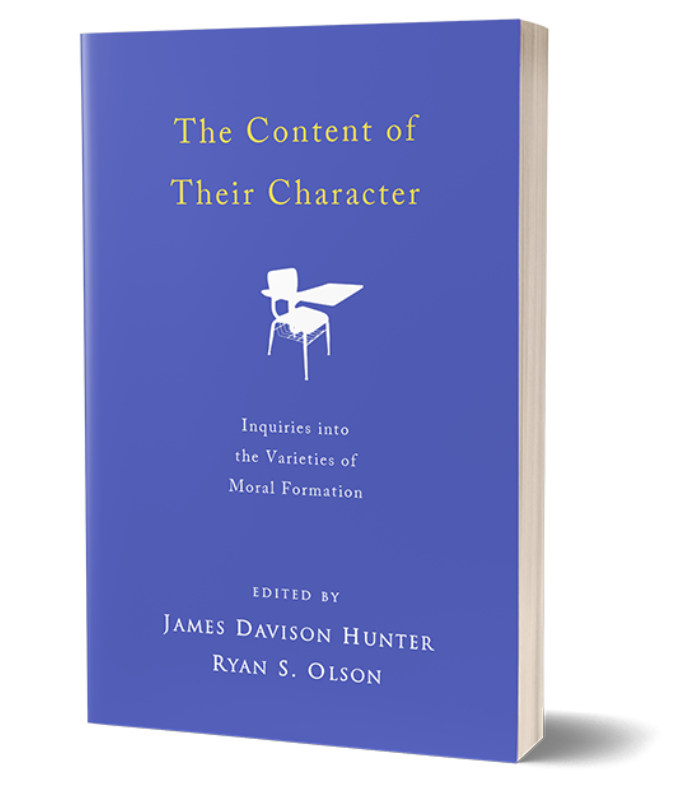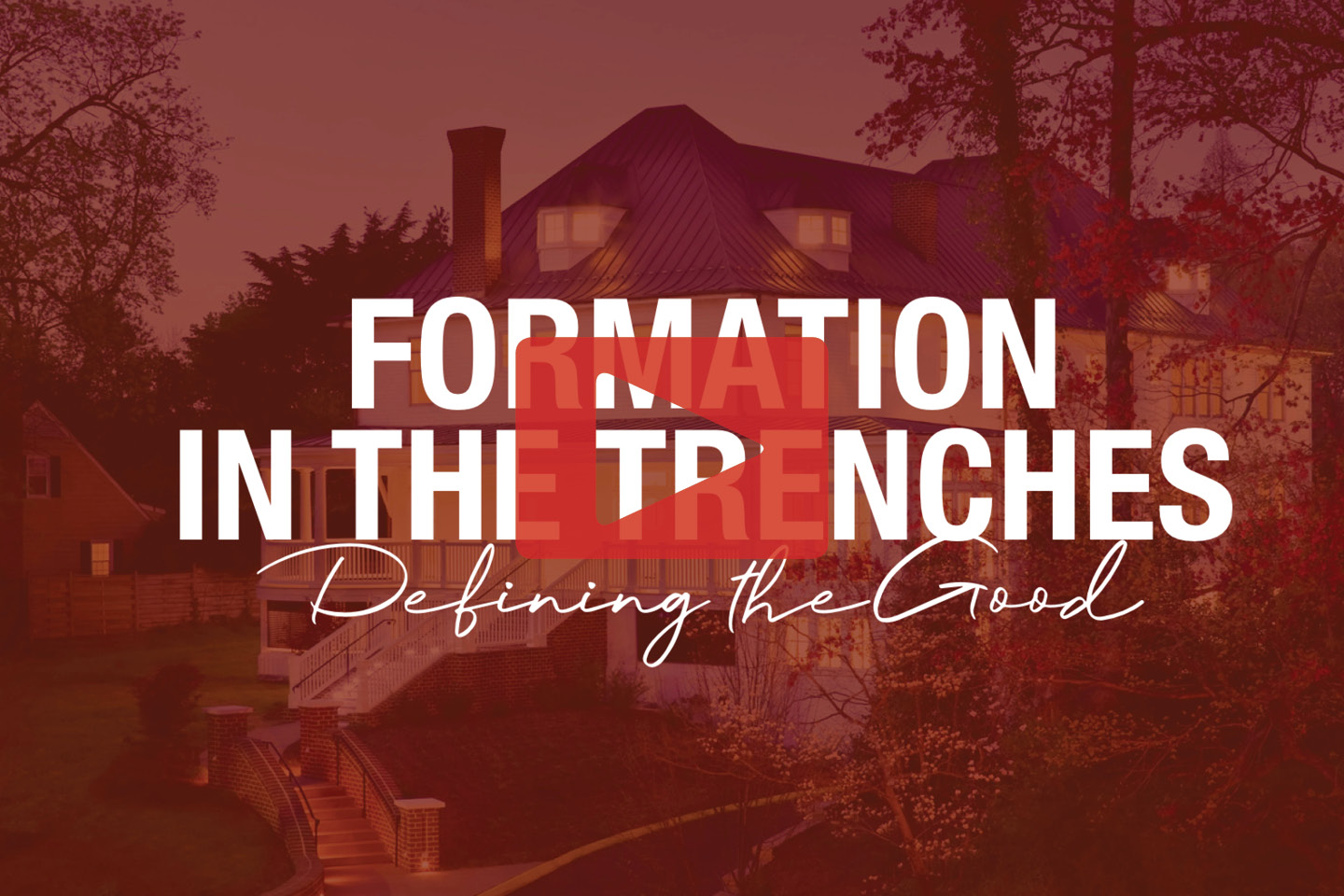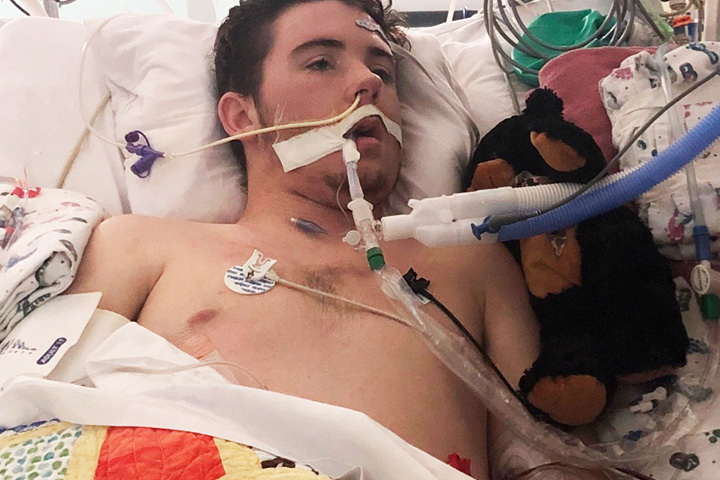To receive a free copy of the chapter of The Content of Their Character that corresponds with this interview, please click here and sign up for our Weekly Digest.
This is a lightly edited transcript of an interview conducted on April 23, 2019, with sociologist Patricia Maloney. Dr. Maloney is Assistant Professor of Sociology at Texas Tech University. She contributed the chapter on charter high schools to The Content of Their Character, a major research project launched by the Institute for Advanced Studies in Culture in order to better understand the moral formation of high school students. The interview was conducted by CultureFeed Editor Joanna Breault.
Joanna Breault: I’m speaking with Dr. Patricia Maloney, who is a soon-to-be associate professor of the sociology of education at Texas Tech University. Several years ago, the Institute for Advanced Studies in Culture at UVA launched a major research project to better understand the moral formation of high school students. Researchers went to ten different sectors of schools from public schools—both urban and rural—to private schools to home schools and other kinds. And Dr. Maloney was one of those researchers. She and her team focused on charter schools. So as we get started today, I want to ask you, Dr. Maloney—thank you for joining us—I want to ask you, could you just to give us a brief explanation of what charter schools are and then what character education looked like in the charter schools that you studied?
Patricia Maloney: Sure. So charter schools are technically public schools in that they do receive funding from public monies, from taxpayer monies, the same way that your more traditional public schools work. The difference with charter schools is that they are founded on a charter, hence the name. I actually, when I explain this to my students, tell them to think of an “XYZ definition.” Charter schools promise to the local board of education or to the state department of education, whatever the certifying entity is, that they will take X number of students for Y number of years and achieve Z test scores in that Y number of years. And basically what they’re saying is, We’re going to take these students from your local traditional public school population. We are not going to be bound by the rules of the traditional public schools, either in terms of teacher unions, in terms of the length of a school day, in terms of the type of curriculum that they have to use, or in terms of what we require from parents, and then at the end of those years, we will have made that Z progress. And so taking some of the burden of students off the traditional public schools but still returning hopefully—not always of course; it doesn’t always happen—but hopefully better test score results than the traditional public schools, and of course better results in terms of graduation rates, and in terms of less quantifiable metrics like culture. And that’s of course where I got really interested in moral education in the culture, with it being taught there.
JB: Thank you; that’s helpful. First of all, I know that you studied six different charter schools, and I know they were really varied, but what were some of the commonalities that you saw between those schools?
PM: So it was really interesting. I mean, I when I talk about charter schools, when I give talks about this, I always talk about the one thing that you know about charters—the one consistency about charters—is that they’re inconsistent. And it sounds flippant, but it’s really the case. Charter schools, at their very core, are designed to be highly individualistic entities, and that’s a double-edged sword, right? If it goes really well, if the school is doing incredibly well, that highly individualistic, that sense of freedom that comes along with being a charter school has worked out brilliantly for all the students and the administrators and teachers involved. On the other side of the coin, when it’s not working so well, there’s no safety net that is necessarily found in the traditional public schools in terms of curricula or teachers’ unions or the ability to move administrators or students from one place to another.
Some charter schools—and there are two types of charters—there are what’s known as networked versus non-networked. The non-networked are the ones that are their own little kingdom. Nobody is giving them any sort of influence from outside, whereas the networked ones are your ones like Kipp, Achievement First, Green Dot, Uncommon Schools; they have a network, hence the reason “networked schools.” And so they do get outside support; support that is external to the school affects them. So to go back to your question about what did I notice about moral education—and it was, oh my goodness, it was fascinating to watch this happen in six different schools and all the way across the country, from Connecticut all the way to California. I noticed that the schools were highly focused on need and what the administrators and the teachers saw as what their students needed to be successful people. And they actually would personalize and design, both formally and informally, their character education systems around what they perceived their students to need. Now that need—their perception of that need—differed significantly by what school we were in, but the teachers and administrators really focused on their students, which I think is probably the case in almost every school around the country.
JB: Can you talk a little bit about what some of those needs were, some of those perceived needs?
PM: Sure. So when we were studying these schools, we came up with different types of schools, different characterizations, of what the schools were and what they valued. The first type that we came up with we called the “equity charters.” In equity charters, the teachers and administrators were laser focused on achieving what they saw as racial and class equity in America. These were schools that were predominantly African American or Hispanic students, very high free or reduced-price lunch, which we use as a measure for poverty.
So what does that mean? That means that these schools were very low-income schools. And the teachers, as teachers tend to be in America, were middle-class, majority white—disproportionately black and Hispanic as compared to other schools—but again, as most teachers are, majority white, middle-class, and there for a reason. Right? They saw their school as a way to help those student overcome the achievement gaps in American society and a way to get them out of those neighborhoods, to try and not only guarantee their intellectual safety if you [will], their intellectual growth, but also in a lot of cases, their personal safety. A lot of teachers told us that “we want to give our kids these tools to get out of these neighborhoods because these neighborhoods are not safe—these kids are gonna be shot.” So this was a mission for these teachers, very much so. So those were the equity charters and that’s what I saw in a lot of those schools.
We also found other schools where, when the racial and class background of the teachers and the students matched—so in schools that were predominantly white and higher income students—the teachers were much less focused on getting students out of a place because, why would they? These were perfectly nice safe neighborhoods. These were the neighborhoods that the teachers themselves grew up in, in some cases. So they, instead of focusing on teaching students morality as a means of getting them out of a situation, very much focused on the academics. I always say that the equity charters focus on “the good person is the good student;” whereas, for a lot of those other schools, the good person wasn’t necessarily a good student because they weren’t worried about their students’ survival. The good person could be a good artist. The good person could be a nice person. Right? I never heard the word “nice” used in an equity charter. So there was a lot more freedom allowed because the teachers were not as personally worried about the long-term job market and personal survival of their students.
JB: That makes sense. But would you say that in all types of the charter schools there was some emphasis on character formation?
PM: Yes, undoubtedly.
JB: Okay. And I know in your chapter you said that there tended to be a lot of agreement among teachers about what a good person looks like and how to achieve that goal. Even when there was maybe discrepancy between the different schools, within a school there was agreement. How do you think that was, that teachers were mostly on the same page about that definition and about how to achieve that goal?
PM: It’s a combination of self-selection and acculturation. The thing that charters have that allows them to develop a greater uniformity of culture, that your traditional public schools do not have, is the fact that almost universally, the charter school principal and other administrators are able to hire their own teachers. So they have a great deal of agency in determining who teaches at their school, so it makes a lot of sense. Why would they hire someone who they didn’t think was a good fit—culture fit—for that school?
And then I also found in a lot of these schools, not all of them, but a lot of them, the acculturation process and the onboarding process, if you will, for a lot of the teachers was all-encompassing and very powerful. Especially because a lot of these charter schools are sort of infamous for having younger teachers. Right? Newer teachers. So of course newer teachers are going to be more likely, younger people are going to be more likely, to fully buy in to a culture system and let that almost be like a path dependency— let that affect what type of teacher they become. Path dependency is the idea that smaller changes, when you get someone early, the smaller little changes that you can make to them, and the smaller little effects, will have larger effects later on that you couldn’t have done if you didn’t get to them early. And so it’s a combination of self-selection and acculturation to get that uniformity. And if a lot of teachers, if they didn’t buy into the system, they left, either through being fired or through quitting.
JB: What were some of the means that you saw where character formation was happening? What kind of methods?
PM: So in the equity schools, the ones that I talked about before that were predominantly low-income, African American students and Hispanic students, they disproportionately were more likely to have formal, very formal, systems with merits and demerits. And so the teacher in some cases could spend as much time, particularly at the beginning of the year, they told me, doing character work. So what does that mean? They would be at the front of the room giving a lecture and they would say, “John, demerit for not sitting up straight,” “Susan, merit for tracking,”—tracking meaning looking at me with your eyes. You know, “Luis, demerit for leaving your seat to do a pencil sharpening”—whatever, you get the point.
So it was highly micro-managing students’ behavior, and they told me that they disproportionately did this at the beginning of the year, again in a path dependency effect. They wanted to make sure that they were harder at the beginning so they could loosen up later. And they would do things like the mottos, and the school’s virtues would be plastered everywhere, and the traditional things like “this month is resilience;” “next month is excellence.” And they would have students write reflection essays. The teachers would have to have at least one lesson a week that touched on that virtue. So really, incredibly formal, highly structured systems that everybody had to buy into. You don’t have a choice in the matter.
And then the teachers would spend a lot of time tallying up things. They had an app they could do on their iPads, like a plus or minus for each student, so it would centralize and sync to the school computer immediately… which, I don’t know about you, but I would lose track of that immediately if I were at the front of the room! But you know, they would have things like, at the end of the week the student with the most points could do this, and students who didn’t have enough points couldn’t do that, and you know, it was a big deal.
Whereas at the schools, particularly at the oldest school in my sample, which was founded in the ‘90s, which—for a charter school—that’s actually really old, because charter schools only started in, I think, 1991, so that’s the founding father we are talking about here. That school, in talking to the principal, actually started as an equity charter, did those sorts of things with highly formal behavior modification systems that were masquerading as character education systems. But that principal, who had been around since the school’s founding, and the other faculty told me that they deliberately relaxed from that over the years, that they weren’t getting good long-term results, that they weren’t actually teaching the character education stuff that they wanted to. They felt that it was way too much of an external locus of control and that when the students left this incredibly structured environment, they regressed—in their words—regressed to behaviors that the teachers and administrators didn’t like.
So instead, in this school, they focus more on relationships with the students. And the word that I kept on thinking when I was writing up my field notes at this school was “calm.” This school was calm. Like, nobody was rushing around like they were in the equity charters; there wasn’t as much emphasis on the academic achievements. It was just, We’re a chill school. And so they were much more focused on informal stuff. They wanted… they still had academic lessons and they still had the mottos on the walls and all that, but the behavior modification system was based on the teacher talking to students and taking them out to the hallway and “what’s going on in your life?” and you know, “maybe we need to have a class meeting about the fact that Johannah is having a rough time.”
And so the criticism that, of course, the equity charters would make of this is that the equity charters almost universally had 95, 96, 97 percent graduation rates and college attendance rates. Rock star statistics. Rock star. Now, the relational charter didn’t have that. Now, they were doing better; they were doing a lot better than the comparative public school down the street. In fact, I think—I’m deliberately fuzzing numbers so that the school is not identifiable—but I’m pretty sure the relational charter had a graduation rate of about 80 percent, which is still excellent for an urban area with lower-income students. But it didn’t have the same college attendance. They said that instead of focusing on academic skills, getting the kids to go to college, they had also a push towards vocational school.
JB: A different goal in mind, even of the character formation.
PM: Yeah, very much so, yeah. And a very different way of doing it. And you know, long-term, the relational charter, the one that focused on relationships, had more data than the equity charters—but will the equity charters turn into relational charters over time? Maybe every one in ten. Maybe.
JB: So not a common model.
PM: I don’t think so.
JB: And did the principal who had been around for a while feel that with the relational model, the good behavior or the moral formation was continuing beyond the walls of the school more?
PM: Yeah, he thought so, because he thought that he was really modeling that you don’t have to be enemies with authority. I absolutely don’t think that the equity charter set themselves up so that the teachers and administrators were the students’ enemies—far from it. I certainly don’t want to malign them and say that. But I do think that students, particularly teenagers, chafe at constant behavior modification, and even though they understood the reason why and agreed with it—like when I talked to the students, they were bought in—nobody likes being told to sit up straight. So it was just a different model.
JB: Sure. So in what ways did the relational charter school foster those relationships?
PM: So a lot of it was smaller class sizes. They took in a lot fewer people. If we think back to that XYZ definition, their X was smaller. A lot of it was because they had been around for so long, they had more money. They had an endowment. And so they were able to have more teachers. They were able to do things like take trips to certain foreign countries. They were able to have more electives where the students could be with teachers who they really wanted to hang out with. And a lot of it was just the culture of instead of the teachers spending time on a lot of paperwork, the idea was to spend time with the kids. Now, again, I mean when I say that, everybody’s like, “yeah of course they should spend more time with the kids and less on paperwork.” But that means that they spent less time on lesson planning, and they spent less time on data analysis and stuff. Again, this is all a double-edged sword, right? I don’t want to set up one particular charter to be the be-all end-all here of character education.
JB: Yes. Well, just transitioning a bit, you did touch on the character trait of grit which has kind of become a popular idea, a buzzword, in the world of charter schools, right? And you did mention that there are several critiques of this concept, and so I just wondered if you could kind of explain what those are and what your perspective is.
PM: Sure. So the name, of course, who everybody associates with grit is Dr. Duckworth, right? Angela Duckworth, who was a professor of mine when I was an undergraduate, actually. And she came up with the concept of grit and said that a lot of how and if we succeed is not necessarily based on intelligence but based on perseverance—how much are you willing to fail and get back up? And so this became a really quick buzzword, particularly in education research that focused on lower-income students because there was this idea.
Some people approached it as a deficiency model: these kids don’t have enough grit; we need to teach grit. We need to teach them how to fail. There’s too much learned helplessness in the low-income [population]. I’m sure you can tell by the way that I’m saying that that I think that that it’s misguided and, in some cases, racist.
There is another model that talks about the fact that grit is not just how willing you are to fail and how willing you are to persevere; it’s also about what you’re persevering in. So I explain it this way when I talked to my students about it, that grit is a muscle. You can build up your perseverance over time if you work at it more and more and more and more. But the same way that a muscle fatigues after being used too much in a given day, so does grit. And if you are a low-income person and using up all your grit on taking care of little sister, finding food, getting yourself to school, dealing with clothes and laundry, you don’t have a ton left for dealing with this horrible social studies teacher who’s trying to get you to learn the Trail of Tears. “What does that have to do with my life?”
But by the same token, your middle class, your higher income kids, who don’t have to think about food or transportation or shelter because mom and dad have got it, can exercise that grit muscle on the academic stuff. So when they get a paper back that is dripping with red ink, they know that if they work hard enough on their next paper, it’ll be better.
The lower income student gets the paper back dripping with red ink and just has no energy to deal with that and has learned that all they’re going to do is fail in school. Why would they try?
So it’s not that something is intrinsically wrong with the lower income students—far from it, far from it. It’s that the structure and the system that they’re in is not allowing them to succeed, to develop and showcase the type of grit that they actually have.
JB: I wish there was… I want to ask you, “so what’s the solution?” But I know that’s the big question, right?
PM: You know, a lot of the schools that I studied spend a lot of time thinking about this, because they’re not stupid people—they’re very intelligent people who care a great deal about their students—they knew exactly what I was talking about. And in fact, in many cases I learned that from them. And so they had systems in place, particularly in the lower-income schools, the equity schools, that had a lot of very, very poor students, where students can bring their laundry to school and do their laundry there. Of course, they had the free and reduced-price breakfast and lunch—almost every school does. But they had dress-up clothes, like a closet, where people could donate stuff to. They had teachers who were willing to teach students about makeup skills to go into a professional setting. A lot of what they were trying to do was trying to teach cultural capital and trying to give these students the skills and the signifiers that are valued by middle-class white America. Now, that opens a whole other can of worms about race and racism and “are these the white savior missionaries?” that I do get into a little bit in the writing—but they’re trying. They’re doing the best they can.
JB: Another issue that I thought was really interesting that you touched on was how, in the equity charter schools, the public and private virtues are difficult to separate. Could you just explain a bit, first of all, what you mean by the difference between private and public virtues, and then kind of how are those interconnected in that type of charter school?
PM: Sure, so public virtues would be more along the lines of that which makes you a good citizen. So let’s see. Really easy examples are—kind of silly examples—are things like paying taxes, and voting, and serving on jury duty, and down to things like… have you seen the “trash tag” stuff that’s going around? Do you know that at all? It’s this whole thing on Instagram and Twitter right now of people who are cleaning up public spaces and then posting the results with the hashtag “TrashTag.” So that I would consider a public virtue, very much so—that which you utilize to make not only your local community but the larger community a better place.
Private virtue is more about that which is going to improve me as a person. And of course, the two are connected, right? These things are certainly not perpendicular. But there is a difference between me making sure that I have healthy food in the house and me making sure that I get up early to write on the next book. That has a connection with who I am as a [person] and certainly will affect my community but not as directly, so it’s more about affecting me.
So your question about “how are these things difficult to separate in the equity charters” is a really good one, because the teachers and administrators in those equity charters, the lower-income predominantly black and Hispanic schools, they are attempting to teach their students academic and professional skills in the hopes of improving the communities that the students are in. And it’s a really overtly stated, clear mission that almost every teacher was willing to just come out and say, that they were trying to… no, I only heard one teacher… no, I heard more than one teacher say this… there was only one teacher who said this this baldly: he said, We are trying to erase what’s happening at home so that we can give them these skills, the correct skills, to go to college, get a good education, and become a professional, in the hopes that this achievement gap will go away, not just by the fact that that person’s children will then be better educated—that student’s children, I mean—but also that the student will turn around and come back and try and help their natal community. I never heard… that was the only time I heard it that baldly that we’re trying to “erase” the at-home. Most teachers soft-pedaled that and talked about “we’re trying to give them additional skills” or we’re trying to give them… you know, the idea of code-switching.
But that was something that they were definitely trying to do, that “we are trying to give these people, these students, knowledge and skills that they will need to succeed in college and in a middle-class to higher-income labor market.”
JB: So in the charter schools that are not equity charter schools, what was the relationship between public and private virtue there?
PM: I’ll give you another example; another one that I went to, I call it the “utility charter” mostly because… I’ll back up. This school is one of the top-performing high schools in the country. Forget “charter public” altogether—it is one of the top-performing high schools in the country. I was actually kind of surprised they let me in, but they were cool with it. So the really interesting thing about this school is that, this was a charter school that was near—trying to talk again without giving away what the school is—its predominant population was professors’ children. And the teachers, of course, knew that and the teachers were from the same sort of background. So when my RAs and I went in to talk to a bunch of different people, they were all kind of surprised that we wanted to talk to them about character education, because they were so used to people coming in and asking them about like academic stuff: “how are you doing this academically?” That [when we’re] asking questions about like character stuff they [say,] “what?”
JB: Not the usual category.
PM: No. Totally of left field for them. And this is actually where I got the clue, where the penny dropped, that it was actually the match between the teachers and the students that was doing the work—because there was such a clear match here between the teachers and the students; in a lot of cases, the students were the teachers’ kids—that they didn’t actually care about character education. Like, I asked them about character education they said, “You mean like behavior systems?” And they said, “We don’t really do that here.” And I said, “No, no—how do you teach what it means to be a good person?” And they all—like, this was a brand-new idea because they were so similar that A. they trusted the parents to do it, and B. they didn’t have to teach it because it’s sort of like a fish was in water; a fish doesn’t realize it’s in water.
It was such a cohesive, tightly coupled system between “at home” and “at school” that I never saw a teacher overtly remonstrate with a student. They would just look at the student out of the corner of their eye and the student would just shut down whatever they were doing. Like, not a problem.
JB: Just in lockstep.
PM: Lockstep. So there was no need to do that, right? To be that overt about it. So to talk about it in the other schools. This school actually said they didn’t do it, but they did do it; they said they didn’t do it, because it was so natural to them, whereas in the other schools, they had to be so overt and so clear about it because it was not as natural.
JB: Yes, that makes sense. And so did the other schools that were aware that they were doing it make a distinction between private and public virtues?
PM: Let’s see. I’m thinking about the last type of school that I haven’t talked about at all which is the “virtue charter”—and oh my goodness, I love this school.
JB: Why don’t you tell us a little bit about that school?
PM: Sure. I love that. That was a great school; that was fabulous. This was a school where you walk in the door and the students had, in art class, each had a square of paper and each student’s job was to do a square of a mural of a larger painting, so that when all the students put their pieces of paper together, the painting was up on the wall for everybody to see, was copied on the wall for everybody—remarkably effectively too; they were really good. I could never pull that off.
And so you would see… let’s see, Aristotle, Plato, Diogenes. One student in particular talked about the nature of the “philosopher king” from Plato. Like, my RA asked her the question of “who is a good person?” and this is what this fifteen-year-old comes out with. Okay. Alright, we’re going there, kid. And so this was a school that was very focused on those classical virtues. Truth, what is truth? What is beauty? Right? What is the nature of man? And I use the phrase “nature of man” deliberately, because that’s the way they would have put it. And they were more focused on the idea of being a well-rounded person. So this was a school that was in a very wealthy area. It was predominantly white, although not completely so, and again, it was very open to having us come in and talk to their kids.
So to go back to your question of public versus private virtue. There I didn’t actually see a ton of separation either; like the equity schools, there wasn’t a ton of separation, but for a very different reason. [In] the equity schools, the virtues—the public and private virtues—were how to be a good student, how to succeed academically, how to succeed professionally, and, you know, “a good student is a good person is a good citizen.” Here they wantedyou to be a good student—I mean, there were consequences if you failed tests or you didn’t do your homework—but it was much more about “a good person contemplates the nature of reality and contemplates the nature of virtue.”
Because they were they were in a wealthy area—again, not worried about their kids not surviving—they had this space, the mental space, to do that, to think about those things. So again, I think that those teachers and those students would say that the private virtue of being truthful in your own life leads to the public virtue of demanding integrity from, for example, one’s politicians.
JB: Well, thank you. Thank you for explaining that and for this entire conversation. It’s been really fascinating to learn about your research and just appreciate you taking the time to speak with me today.
PM: Oh, it’s good to get to talk about it. I’ll talk anyone’s ear off.


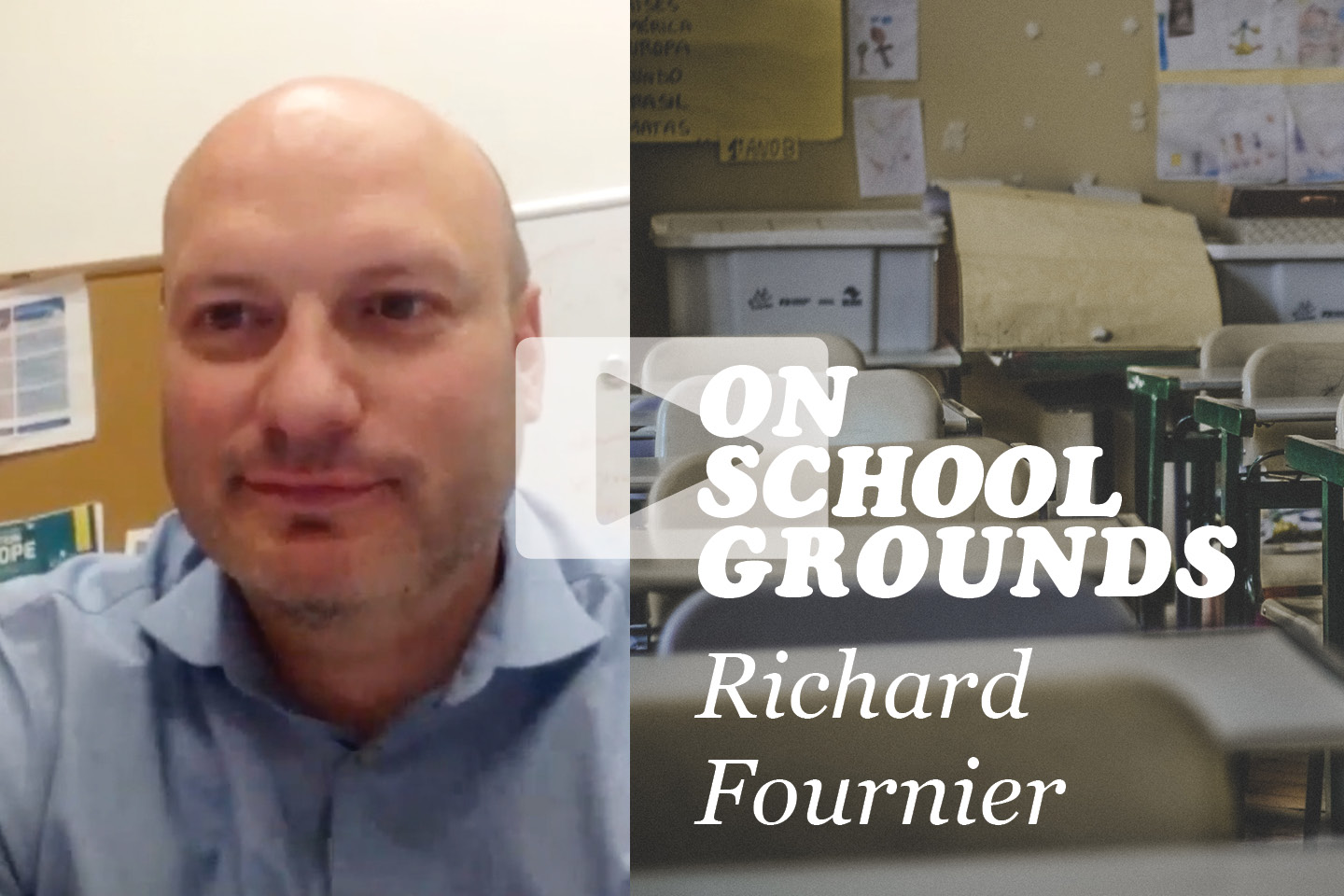
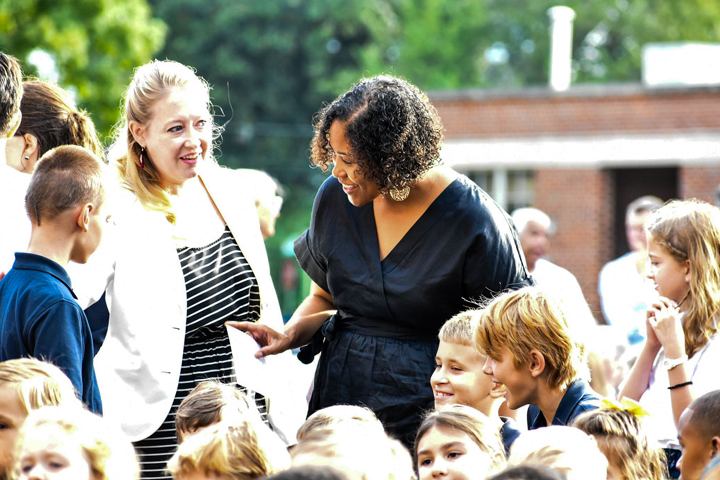

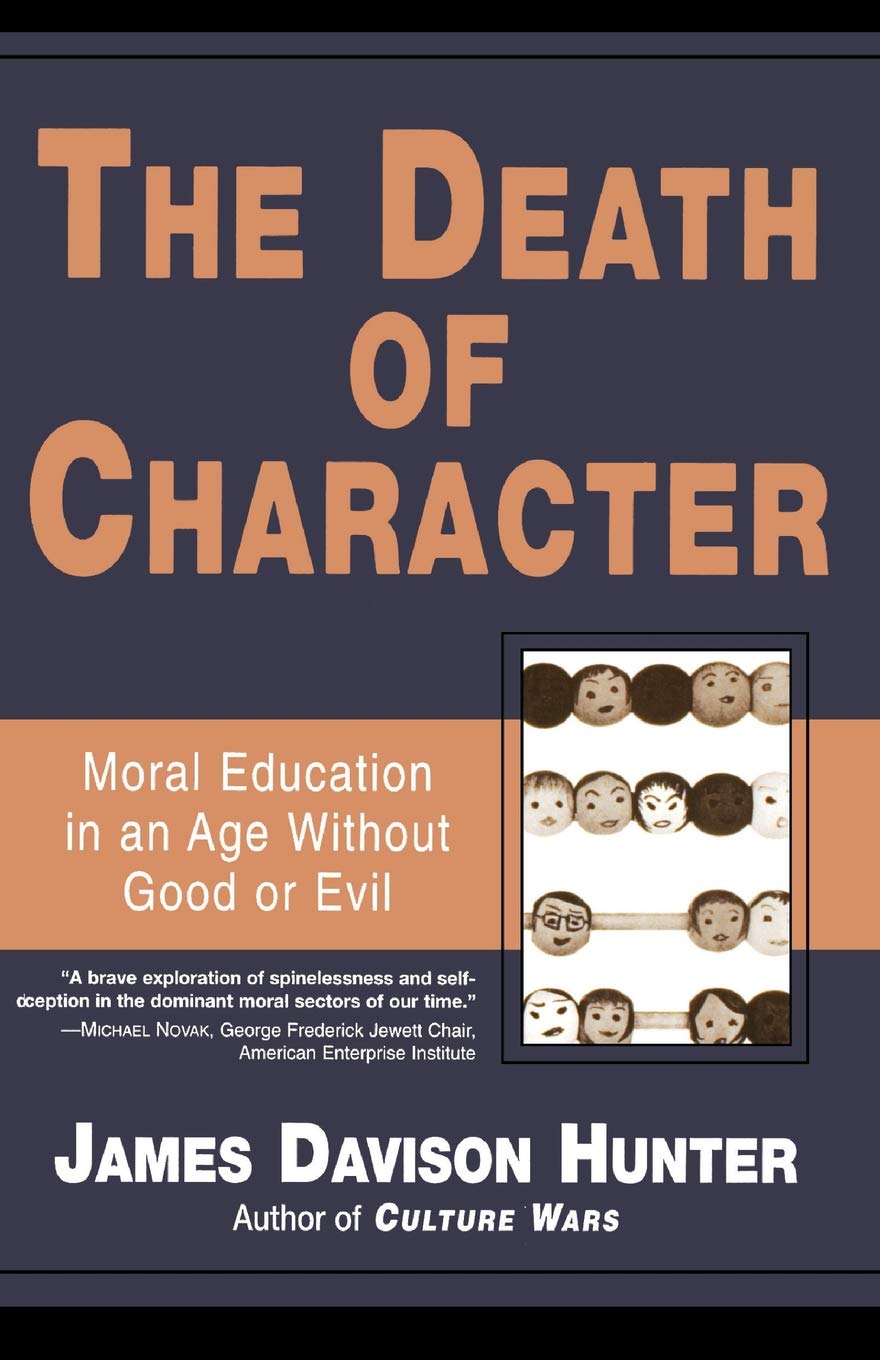 And then I read The Death of Character. Its impact was dramatic. Suddenly, I understood why almost none of the programs seemed to be working. They weren’t working because there was a fundamental design flaw.
And then I read The Death of Character. Its impact was dramatic. Suddenly, I understood why almost none of the programs seemed to be working. They weren’t working because there was a fundamental design flaw.